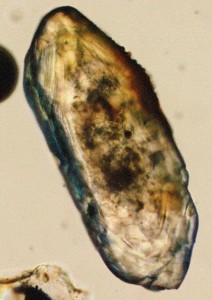Very interesting seminar today from Prof. Blair Schoene of Princeton University’s Dept. of Geosciences. Prof. Schoene discussed his work on geochronology, estimating the ages of rocks.
The Earth is very old, and figuring out the ages of rocks can be tricky. Luckily, the Earth provides some help, notably in the form of small crystals called zircons (one shown at left). Zircons are hardy little crystals that contain trace amounts of uranium (U) and lead (Pb). When zircons crystallize, they can incorporate some U into the crystal, but Pb is chemically excluded.
However, U radioactively decays into Pb at a well-known rate, and so if you find Pb in an old zircon, you know that it used to be U and formed by decay. By counting up the amount of Pb, you can estimate the zircon’s age.
Prof. Schoene and his research group use this fact to estimate the ages of rocks on the Earth’s surface. This work can tell us, for example, whether the chemistry of lavas erupted onto the surface have changed over time.
In fact, work by Schoene’s group has found preliminary indications that there may have been a big shift in the chemistry of lava flows right about the time that oxygen appeared in abundance in the Earth’s atmosphere, 2.5 billion years ago during the Great Oxygenation Event (GOE). The GOE is suspected to have devastated Earth’s biosphere — oxygen was toxic to most life at that time — and now it seems that eruptions from the Earth’s interior were affected, too.
